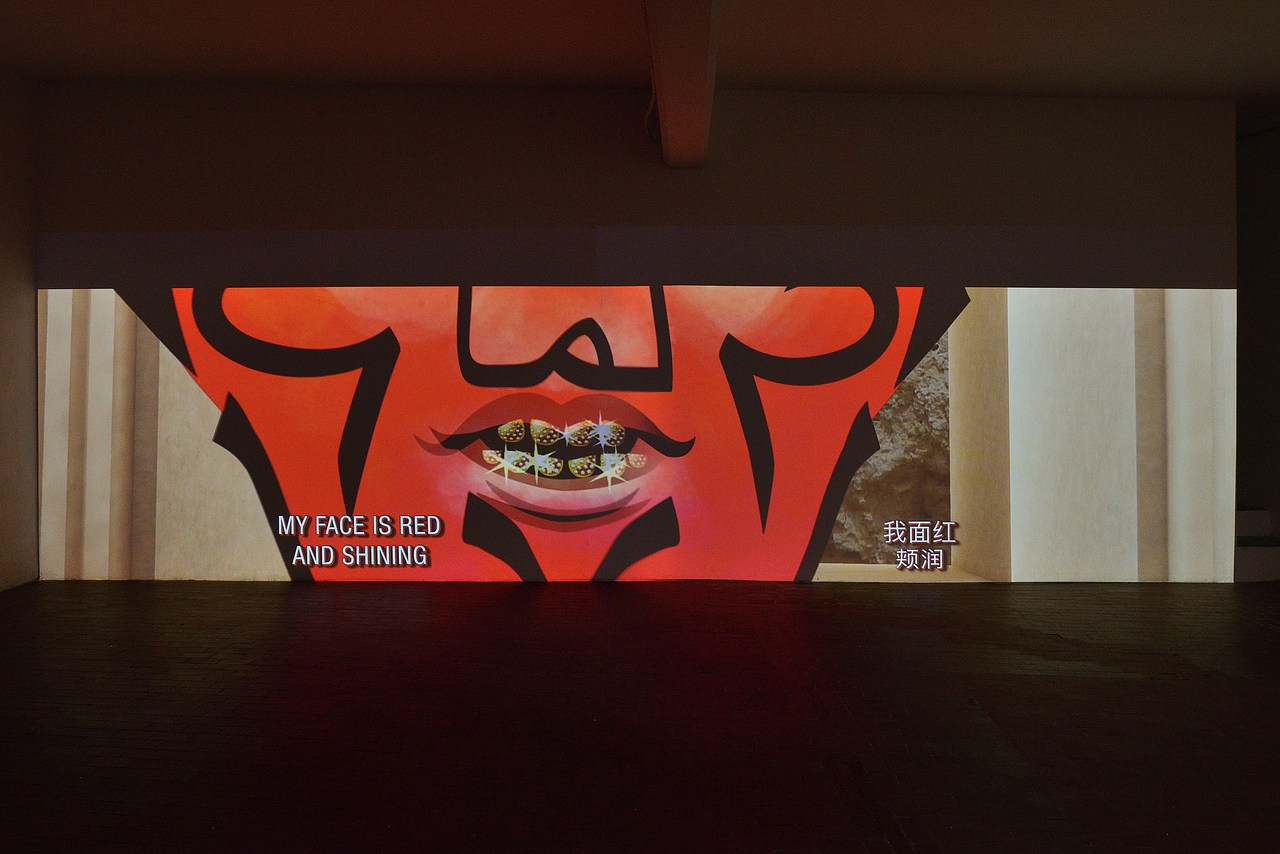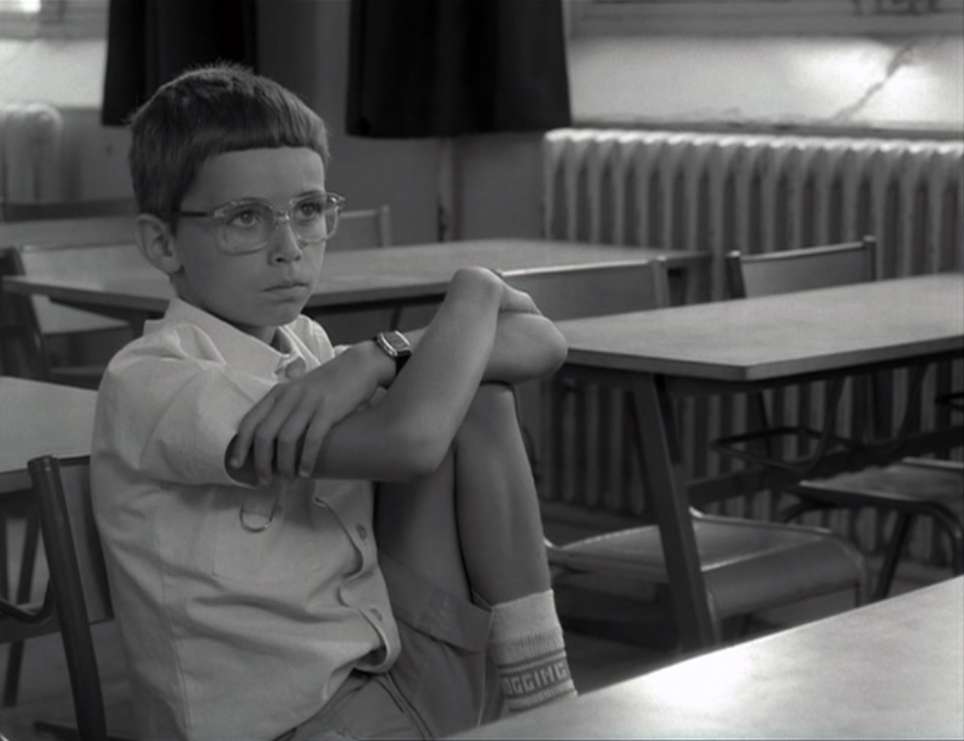
© » KADIST
Pooja Gurung and Bibhusan Basnet
DADYAA: The Woodpeckers of Rotha by Pooja Gurung and Bibhusan Basnet illuminates a unique and seldom seen international perspective on indigenous cultures and contemporary social issues in the Nepali context. A small masterpiece, the work engages with one of the most pressing social issues in Nepal, mass migration and the dissolving of social fabric in rural areas. The story begins with an old couple, Atimaley and Devi, who live in a village in Jumla, in the highlands of Western Nepal.

© » KADIST
Nagendra Gurung
Chalis Katesi Ramaula is a series of 240 prints capturing Nagendra Gurung’s life, work, and colleagues from the construction sites where he has worked in Dubai and Saudi Arabia. When seen together, the sequence appears to have a cinematic temporality, as one feels the passing of the years he has endured as a migrant worker. Gurung’s subjectivity is highly present, even when looking at the most banal scenes of cranes, concrete, and other machinery, which are rapidly transforming the landscape and society of the Gulf into its own version of capitalist futurism built through the exploitation of others.

© » KADIST
Hit Man Gurung
Hit Man Gurung’s series I Have to Feed Myself, My Family and My Country… addresses labor migration, a phenomenon prevalent in South Asian countries like Nepal. The laborers, most of whom are young and middle-aged, come from marginalized and underprivileged backgrounds. They leave their families back in the homeland with the dream of pursuing a better life for themselves and their families.

© » KADIST
Miguel and Natalia Fernández de Castro and Mendoza
The Absolute Restoration of All Things is a collaboration by artist Miguel Fernández de Castro and anthropologist Natalia Mendoza. For this project, Fernández de Castro and Mendoza researched the 2014 court case that shut down Penmont Mining’s operations in the middle of the Sonoran desert. The lawsuit was brought to court by the “ejidatarios” (communal land holders) of El Bajío, Sonora, who claimed that their territory was illegally occupied and exploited, causing an irrevocable environmental impact on their land.

© » KADIST
Chantal Edie and Zacharie Ngnogue
Au non de la liberté (Tiko drink Kumba drunk) is a photographic series by Zacharie Ngnogue and Chantal Edie that considers the correlation between those who hold power in Cameroon and how their actions affect the populations they rule in often compromising ways. “Tiko drink-Kumba drunk” is an adage that is commonly used in the Southwest province of Cameroon to speak of how one’s actions affect others. Civil liberties are next to non-existent in Cameroon, the law is lawless, and structured in a way that is intended to attack its citizens’ human rights.

© » KADIST
John Lucas and Claudia Rankine
Drawing & Print (Drawing & Print)
Historically, blondeness has been a signifier for desirability and beauty, speaking to “purity” — the purity of whiteness — like no other bodily attribute except, perhaps, blue eyes. In the twenty-first century, blondeness is the look desired by American presidents, pop stars, rappers, television announcers, Hollywood celebrities, the boy next door, and some Asian Americans, African Americans, white Americans, Arab Americans, and LatinX Americans. The desirability of blonde hair has no genre boundaries, no pronoun limitation, and no class limit.

© » KADIST
Olive Martin and Patrick Bernier
The Mohawk, the emblematic Frontier river in the period of American colonisation, is here a cable of data transmission, and the 7 Sultans Casino is a virtual destination, one of the three hundred online casinos hosted by the servers located in Kahnawake, a small native american indian reserve to the south of Montreal. Incorporating poker, challenges to the law, a struggle for the control of a new territory where the stakes are high, our film ‘La Nouvelle Kahnawake’, between fiction and documentary, pushes these analogies with the Western to explore both our relationship to the figure of the ‘Indian’ and the confusion of our perception of space that new information technology has brought about. As the artists state: “We are neither anthropologists nor journalists.

© » KADIST
Pauline Boudry and Renate Lorenz
Salomania sees choreographer and filmmaker Yvonne Rainer and artist Wu Tsang rehearse scenes from Valda’s Solo , a chapter of a film Rainer made in 1972 after having seen women perform the dance of the seven veils in Alla Nazimova’s 1923 silent film Salomé . The script is based on the Biblical New Testament story of the Jewish princess Salomé, who in the Christian tradition has been depicted as an emblem of feminine seduction and danger. In the twentieth century, her character was made popular through English playwright Oscar Wilde’s famous theater piece, Salomé .

© » KADIST
Ei Arakawa and Sergei Tcherepnin
Part of a series entitled “Looking at Listening”, 2011, the piece invited the spectator to experiment and consider sound as a kinetic and synesthetic process, where multiple experiences and senses can cross. The presented photographs were selected from the New York Public Library and found in an archive called ‘Listening,’ with the sub-genres ‘town meetings,’ ‘investigation,’ ‘audiences 1960–1970’ and ‘conversation.’ Taking the photographs from the city’s archive of frozen moments of audio exchange, Arakawa and Tcherepnin give sound and movement back to past moments. In each of the photographs, people are listening in different situations—public, and private.

© » KADIST
John Wood and Paul Harrison
One of John Wood and Paul Harrison’s earliest works, Device features Harrison performing a series of actions, assisted by the titular ‘devices’, that use physics to force his body into unusual and uncomfortable positions. Maintaining his signature deadpan expression throughout the video, in one scene Harrison is thrusted into the air by a slowly inflating balloon until only his feet are visible in the frame, while in another he levitates in diving position with the help of a pulley system. Wood uses his body and specially-designed props created by the artist duo to explore the space of the screen in hilarious, and sometimes clumsy or violent, ways.

© » KADIST
The Propeller Group and Superflex
Fade In (the whole title of the film is actually the entire five page script) is a collaboration with the Danish artist collective Superflex (group of freelance artist–designer–activists committed to social and economic change, founded in 1993 by Jakob Fenger, Rasmus Nielsen and Bjørnstjerne Christiansen). There are several time layers to understand the story behind this film. In 1601, the San Jago set sail from Goa for Lisbon; the cargo included the first consignment of South East Asian porcelain destined for the European market.

© » KADIST
Maayan Amir and Ruti Sela
In Beyond Guilt the two artists create a portrait of our generation in three parts. In Tel Aviv, in confined spaces such as toilets or bar of hotel rooms, they create situations in which participants answer questions and describe themselves. Camera in hand, there is little editing in their works, leaving a rather crude result.

© » KADIST
John Wood and Paul Harrison
3-Legged is an early video work by John Wood and Paul Harrison in which they appear with their legs tied together (as one would do in a three-legged race). Wood and Harrison stand together in a narrow alcove built into their studio, dressed similarly in grey long sleeve shirts and jeans. Facing a tennis ball machine that is almost completely out of view, with only the barrel of the machine protruding from the bottom of the frame, they hobble back and forth across the alcove attempting to avoid the tennis balls launching toward them, with varying degrees of success.

© » KADIST
Köken Ergun and Satyam Mishra
Nepal and China signed an agreement for the Belt and Road Initiative (BRI) in 2017. The BRI is a strategy that was set forth by China in 2013 to expand its influence by building a network of economic corridors around the globe. BRI projects in Nepal include the Kathmandu-Kerung Railway, the Galchhi-Rasuwagadhi-Kerung 400 kilovolt transmission line, the 762 megawatt Tamor hydroelectric dam, and the 426 megawatt Phukot Karnali run-of-the-river hydropower project.

© » KADIST
Ana Navas
Ana Navas uses humor to address formal, aesthetic, and societal conventions that are interwoven in the everyday through the normalization of gendered behaviors and style choices used to project personal and collective signifiers. In her Donation Vases she uses quotes taken from corporate coach Lois P. Frankel’s book Nice girls (still) don’t get the corner office: Unconscious Mistakes Women Make That Sabotage Their Careers (2004). The aspirational, somewhat cynical tone of the sentences – “When given a choice, sit next to most powerful person, their power will cascade over you,” “Why is it that women buy those little chains to hang reading glasses around their necks,” “If you see your reflection on a glossy surface & notice something wrong, avoid fixing it there” – reveals a particular understanding of what a professional, ambitious cis woman should look like, the persona she should project, and the type of desirable behaviors that constitute a stereotypical “successful woman” according to a capitalist morality.

© » KADIST
Ana Vaz
Ana Vaz describes her film É Noite na América (It is Night in America) as an eco-terror tale, freely inspired by A cosmopolitics of animals by Brazilian philosopher Juliana Fausto; in which she investigates the political life of non-human beings and questions the modern idea of the exceptionality of the human species. In parallel to the feature film version, Vaz created a three-channel installation format meant to be displayed in contemporary art spaces. This edition includes three complementary video works that expand on the conceptual frameworks of the film.

© » KADIST
Ana Roldán
Ana Roldán’s Primeval forms series looks up close at the fecund shapes of plants often found in the artist’s native Mexico. These botanical portraits, like this one of the Pseudobombax ellipticum, or shaving brush tree, bristle against the edges of the image’s frame, fecund and wild, familiar yet foreign. Ana Roldán works in diverse media such as performance, sculpture, installations, video and collage.
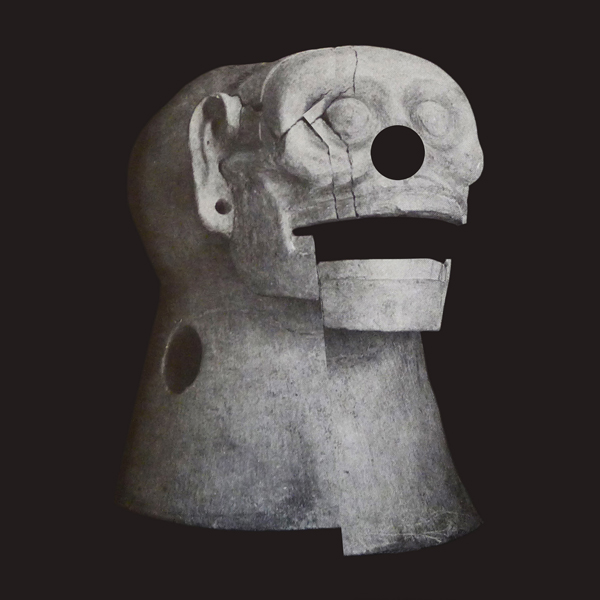
© » KADIST
Ana Roldán
Ana Roldán’s Displacements works use images taken from a 1970s exhibition catalogue for an exhibition called The Death in Mexico. Using pre-Columbian objects and other artifacts from Mexican history, the exhibition aimed to explore various representations of death in the Mexican cultural tradition. Roldán’s works begin with these rich black-and-white photographs and break them apart into fragments, slicing and dismembering the artifacts they depict.
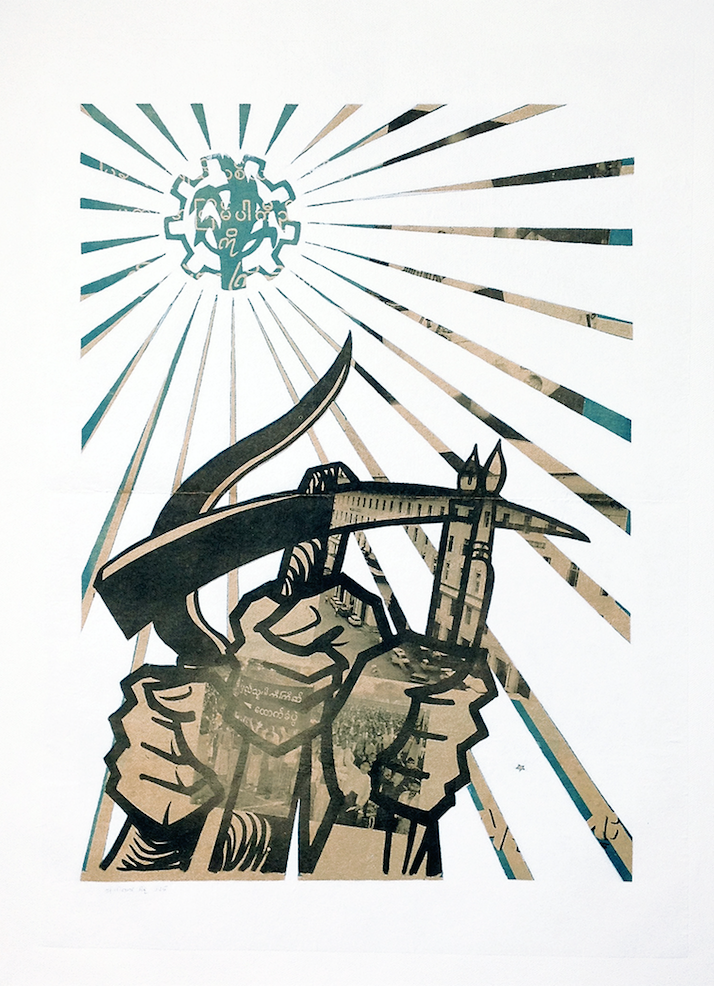
© » KADIST
Tun Win Aung and Wah Nu
Tun Win Aung and Wah Nu initiated the series 1000 Pieces (of White) in 2009, as a way to produce objects and images as a portrait of their shared life as partners and collaborators. Interweaving public and private, personal anecdote and pop cultural appropriation, their work attests to the poetry of the everyday. In addition to found and original materials, the artists have occasionally incorporated drawings and sketches by artist friends, and even by their own daughter into the ongoing work.

© » KADIST
Leung Chi Wo and Wong Sara
Office Lady with a Red Umbrella restages a figure from a 1980 postcard made from a photograph from 1950’s. The retro-glamor of the 1950s style is restyled devoid of the original context of a Hong Kong street scene, where the “office lady” is walking on Queens Road of the Central district. With the “office lady” facing away from the viewer with a bare background, an introspective tone is created in Leung’s restaging while highlighting the red umbrella resonating with a red pencil skirt emblematic of the identity of the professional urban woman when Hong Kong was under British rule.

© » KADIST
Christine Sun Kim and Thomas Mader
Indexes that either allow or inhibit the establishment of communication exist in both signed as well as spoken languages. Some differ radically depending on a variety of social, economic and geographical factors, while others are universally understood. Seemingly small and fleeting gestures can determine a sense of affiliation or a feeling of rejection.
![Elevación [Elevation]](https://kadist.org/wp-content/uploads/2022/09/IMG_escena001_3513-scaled.jpg)
© » KADIST
Ana María Millán
Interested in role-play and videogames, Ana María Millán developed workshops with different communities in order to create characters and scenarios for her animations, often in collaboration with a choreographer. Elevación evokes various narratives inspired by the comicstrip Marquetalia, Raíces de la Resistencia (Marquetalia, Roots of the Resistance) (2011). This comic strip is a memoir of the FARC (Revolutionary Armed Forces of Colombia) guerillas written by Jesús Santrich, one of its leaders who, after the 2016 Peace Agreement, rejoined dissident members of the organization in a clandestine guerrilla splinter group in 2019.

© » KADIST
Ana Teresa Fernández
Drawing & Print (Drawing & Print)
The artist writes about her work Borrando la Frontera, a performance done at Tijuana/San Diego border: “I visually erased the train rails that serve as a divider between the US and Mexico. I painted them sky blue, creating a “Hole in the Wall” This deconstruction of “feminized” work explores the difficulties in reconciling both low wages and undervalued work via social and political infrastructures, confronting issues of labor and power. The images that I myself perform, present a duality: women dressed in a black tango dance attire while engaging in de-skilled domestic chores; the surreal within non-fiction.

© » KADIST
Ad Minoliti
In Ad Minoliti’s expansive three-panel painting Abstracción geométrico-galáctica the artist’s hallmark geometric abstractions serve as playful substitutes for more straightforward depictions of the world. A departure from previous bodies of work that explore the modern interiors of 1960’s-era American homes, porn sets, and jungles, Abstracción geométrico-galáctica launches the artist’s geometric characters into space for the first time. The work draws directly from Minoliti’s experience with The Feminist School of Painting .

© » KADIST
Ad Minoliti
G. S. F. C. #3 (Geometrical Sci-Fi Cyborg) belongs to a series of paintings that build upon the artist’s exploration into feminist speculative fiction and the cyborg as a creature of contemporary reality and fiction. The cyborg painting, as she calls it, is made through a smearing of human and machine in which the composition of color landscape with outlines of anthropomorphized forms is stenciled and airbrushed onto canvas, then photographed an printed onto canvas. Once this is done, Minoliti goes back over the printed canvas with paint.

© » KADIST
Gabriella and Silvana Mangano
There is no there by Gabriella and Silvana Mangano is a black and white looped video with sound, in conjunction with a live performance. The work is inspired by the Blue Blouse, a political propaganda theater movement which spread across the Soviet Union in the mid-1920s. More specifically, the work takes the form of ‘Living Newspapers’, which were performances based on topical news events.

© » KADIST
Slavs and Tatars
Wheat Mollah ( 2011) is one of Slavs and Tatars composite object. The title Wheat Mollah has various interpretations, from “master” or spiritual authority for Shiites and “friend” for Sunnis. The turban is also worn in a diversity of cultures and religions in Africa, Asia and India.

© » KADIST
Michelle and Noel Keserwany
Les Chenilles by Michelle and Noël Keserwany is a sensual film that translates the source of women’s oppression into the means for their liberation. In this narrative film, protagonists Asma and Sarah meet while working as waitresses in France. They both come from the Levant and, each in their own way, carry burdens of the past and the consequences of colonialism.
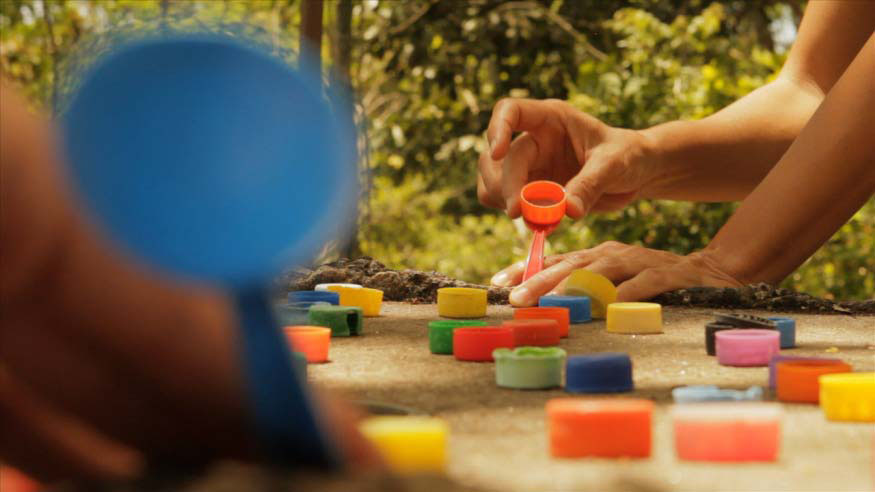
© » KADIST
Donna Conlon and Jonathan Harker
In Tapitapultas (2012), Donna Conlon and Jonathan Harker comment on mass consumerism and pollution by way of a game they invented. The artists used disposable spoons as catapults to shoot thousands of plastic bottle caps at a hole in a concrete platform. The platform was once part of a U. S. military installation in the Panama Canal Zone, and it is now an observation deck in a nature park.

© » KADIST
Köken Ergun and Tashi Lama
Nepal and China signed an agreement for the Belt and Road Initiative (BRI) in 2017. The BRI is a strategy that was set forth by China in 2013 to expand its influence by building a network of economic corridors around the globe. BRI projects in Nepal include the Kathmandu-Kerung Railway, the Galchhi-Rasuwagadhi-Kerung 400 kilovolt transmission line, the 762 megawatt Tamor hydroelectric dam, and the 426 megawatt Phukot Karnali run-of-the-river hydropower project.
Chantal Edie and Zacharie Ngnogue
Chantal Edie and Zacharie Ngnogue are a photography duo who channel their personal experiences into social commentaries...
Ad Minoliti
Ad Minoliti is a painter who combines the pictorial language of geometric abstraction with the perspective of queer theory...
Ana Vaz
Ana Vaz is an artist and filmmaker whose works speculate on the relationships between self and other, and myth and history, through a cosmology of signs, references, and perspectives...
Leung Chi Wo and Wong Sara
Leung Chi Wo tends to highlight in his art the boundaries between viewing and voyeurism, real and fictional, and art and the everyday...
An-My LE
- location: New York, New York
- year born: 1960
- gender: female
- home town: Saigon, Vietnam
Ho Rui An
The artist, writer, and researcher Ho Rui An probes histories of globalization and governance, performing a detournement of dominant semiotic systems across text, film, installation, and lecture...
Mary Ann Aitken
Mary Ann Aitken was known to be very private about her art practice; she was considered somewhat of an outsider by her peers affiliated with the second wave of Detroit’s Cass Corridor arts movement...
John Wood and Paul Harrison
John Wood and Paul Harrison have been working collaboratively since 1993, producing single screen and installation-based video works...
Slavs and Tatars
Self-described as an “Eurasian-based” collective, Slavs and Tatars investigates the “polemics and intimacies” of the region “east of the former Berlin Wall and west of the Great Wall of China” or Caucasia...
Michelle and Noel Keserwany
Michelle and Noël Keserwany compose and perform their own songs, as well as contribute to the illustrations and animations featured in the videos they produced...
Ei Arakawa and Sergei Tcherepnin
Ei Arakawa and Sergei Tcherepnin began their audio-visual and performative collaboration in 2007...
Musquiqui Chihying and Gregor Kasper
Through his artistic career, Musquiqui Chihying has striven to dislocate and reconstruct established modes of behavior within systems and structures of power...
Jane Jin Kaisen and Guston Sondin-Kung
Working with narrative experimental film, multi-channel video installation, performative video art, photography, and text, Jane Jin Kaisen engages themes of memory, trauma, migration and translation at the intersection of personal and collective histories...
Donna Conlon and Jonathan Harker
- location: Panama City, Panama
- year born: 1966
- nationality: American and Ecuadorian
Tun Win Aung and Wah Nu
Wah Nu and Tun Win Aung, respectively born in 1977 and 1975, Yangon, Myanmar...
Nagendra Gurung
Since the mid-2000s, Nagendra Gurung has practiced photography in parallel to his life as a migrant worker in Dubai and Saudi Arabia...
Etel Adnan and Lynn Marie Kirby
Visual artist, poet, and essayist Etel Adnan writes what must be communicated through language, and paints what cannot...
Jonas Van and Juno B
Although Jonas Van and Juno B do not belong to a collective, this collaborative video reflects their individual practices and their complex subjectivities...
Pauline Boudry and Renate Lorenz
Working together since 2007, artist duo Pauline Boudry and Renate Lorenz conduct research on the heritage of cultural and gender studies, concentrating primarily on gender discourses and the notion of queer...
Pooja Gurung and Bibhusan Basnet
Pooja Gurung and Bibhusan Basnet have a joint practice that merges film and visual art...
Olive Martin and Patrick Bernier
Patrick Bernier and Olive Martin are a duo of artists collaborating since 1999...
Jordan Ann Craig
Jordan Ann Craig is a Northern Cheyenne artist born and raised in the Bay Area; she invests her work with a strong interest in Indigenous culture and the history of its destruction by settlers...
Angela Detanico and Rafael Lain
Linguists, semiologists, and graphic designers by training, Angela Detanico and Raphaël Lain consider the use of graphic signs in society...
Ana Navas
Ana Navas’s practice deals with the vulgarization of modern art, understanding the term vulgar in its original sense of being appropriated by common people...
Jay Chung and Takeki Maeda
Jay Chung and Takeki Maeda’s practice is characterized by performance, which often involves weighty unsettling humour...
Maayan Amir and Ruti Sela
Maayan Amir and Ruti Sela, two young Israeli women artists work collaboratively or individually by project...
Gabriella and Silvana Mangano
Gabriella Mangano and Silvana Mangano are an artistic duo and identical twins known for their collaborative and performative video practice...
Christine Sun Kim and Thomas Mader
Christine Sun Kim and Thomas Mader have been collaborating for the last 5 years, covering communication in a variety of formats such as recording an overnight shipment from Berlin to New York ( Recording Contract , 2013), compiling 24 hours of invited contributors’ studio time ( Busy Day , 2014), and using the arm game, a combination of body and face, in order to describe a series awkward situations ( Classified Digits , 2016)....
The Propeller Group and Superflex
The Propeller Group was established in 2006 as a cross-disciplinary structure...
Hit Man Gurung
Hit Man Gurung was born in Lamjung, Nepal and is currently based in Kathmandu...

© » APERTURE
about 4 months ago (12/01/2023)
For the past two decades, An-My Lê has used photography to examine her personal history and the legacies of US military power, probing the tension between experience and storytelling....
-
1980-1989
Jean-Marie Straub and Danièle Huillet
1982En rachâchant is based on the short story Ah! Ernesto! (1971) by Marguerite Duras in which the child Ernesto does not want to go to school anymore as all that he is taught are things he does not know...
-
1990-1999
John Wood and Paul Harrison
1996One of John Wood and Paul Harrison’s earliest works, Device features Harrison performing a series of actions, assisted by the titular ‘devices’, that use physics to force his body into unusual and uncomfortable positions...
John Wood and Paul Harrison
19973-Legged is an early video work by John Wood and Paul Harrison in which they appear with their legs tied together (as one would do in a three-legged race)...
-
2000-2009
Mary Ann Aitken
2002Untitled (Boom Box, Double-Sided) by Mary Ann Aitken is representational painting of a boom box on an unconventionally long canvas painted on both sides, to mimic the scale and appearance of the actual appliance...
Maayan Amir and Ruti Sela
2003In Beyond Guilt the two artists create a portrait of our generation in three parts...
Nagendra Gurung
2005Chalis Katesi Ramaula is a series of 240 prints capturing Nagendra Gurung’s life, work, and colleagues from the construction sites where he has worked in Dubai and Saudi Arabia...
Pauline Boudry and Renate Lorenz
2009Salomania sees choreographer and filmmaker Yvonne Rainer and artist Wu Tsang rehearse scenes from Valda’s Solo , a chapter of a film Rainer made in 1972 after having seen women perform the dance of the seven veils in Alla Nazimova’s 1923 silent film Salomé ...
Jay Chung and Takeki Maeda
2009Jay Chung and Q Takeki Maeda remake a clip from the 1970s they found on the internet, and without really changing this archive material, displace it by imitating the staging and the acting with scrupulous precision...
Mary Ann Aitken
2009Untitled (Diptych) by Mary Ann Aitken is a pair of paintings; one entirely abstract and the other a hybrid of representational and abstract elements...
-
2010-2019
Olive Martin and Patrick Bernier
2010The Mohawk, the emblematic Frontier river in the period of American colonisation, is here a cable of data transmission, and the 7 Sultans Casino is a virtual destination, one of the three hundred online casinos hosted by the servers located in Kahnawake, a small native american indian reserve to the south of Montreal...
The Propeller Group and Superflex
2010Fade In (the whole title of the film is actually the entire five page script) is a collaboration with the Danish artist collective Superflex (group of freelance artist–designer–activists committed to social and economic change, founded in 1993 by Jakob Fenger, Rasmus Nielsen and Bjørnstjerne Christiansen)...
Leung Chi Wo and Wong Sara
2010Office Lady with a Red Umbrella restages a figure from a 1980 postcard made from a photograph from 1950’s...
An-My LE
2010The print Patient Admission, US Naval Hospital Ship Mercy, Vietnam (2010) features an Asian Buddhist monk and an American Navy Solider on board the Mercy ship –one of the two dedicated hospital ships of the United States Navy– sitting upright in their chairs and adopting the same posture...
Jane Jin Kaisen and Guston Sondin-Kung
2010The Woman, The Orphan, and The Tiger begins with the sound of women’s voices describing histories of violence, of things repressed and silenced...
Leung Chi Wo and Wong Sara
2010Photojournalist with Two Cameras restages a portrait of a photojournalist from the background of an old photograph of protest published in South China Morning Post on January 10, 2010 under the headline “Return of the Radicals: Recent angry protests are nothing new.” The photojournalist in the photograph, probably from a protest of earlier decades, was capturing the scene of a protester’s arrest while wearing two cameras...
Võ An Khánh
2010In Extra Curriculum Political Science Class 7/1972 , a group of women walk bare-foot and single file towards Dat Mui Mangrove in Ca Mau Province to attend ‘political science class’...
Ei Arakawa and Sergei Tcherepnin
2011Part of a series entitled “Looking at Listening”, 2011, the piece invited the spectator to experiment and consider sound as a kinetic and synesthetic process, where multiple experiences and senses can cross...
Tun Win Aung and Wah Nu
2011Tun Win Aung and Wah Nu initiated the series 1000 Pieces (of White) in 2009, as a way to produce objects and images as a portrait of their shared life as partners and collaborators...
Ana Teresa Fernández
Drawing & Print
2011(Drawing & Print) The artist writes about her work Borrando la Frontera, a performance done at Tijuana/San Diego border: “I visually erased the train rails that serve as a divider between the US and Mexico...
Ana Roldán
2012Ana Roldán’s Primeval forms series looks up close at the fecund shapes of plants often found in the artist’s native Mexico...
Ana Roldán
2012Ana Roldán’s Displacements works use images taken from a 1970s exhibition catalogue for an exhibition called The Death in Mexico...
Donna Conlon and Jonathan Harker
2012In Tapitapultas (2012), Donna Conlon and Jonathan Harker comment on mass consumerism and pollution by way of a game they invented...
Gabriella and Silvana Mangano
2015There is no there by Gabriella and Silvana Mangano is a black and white looped video with sound, in conjunction with a live performance...
João Maria Gusmão and Pedro Paiva
2015The artist duo João Maria Gusmão and Pedro Paiva traveled to Japan for a month to make a series of short 16mm films, often shot in slow-motion...
Christine Sun Kim and Thomas Mader
2016Indexes that either allow or inhibit the establishment of communication exist in both signed as well as spoken languages...
Etel Adnan and Lynn Marie Kirby
Drawing & Print
2017(Drawing & Print) In conjunction with KADIST’s 2017 exhibition If Not Apollo, the Breeze , artist and filmmaker Lynn Marie Kirby performed Transmissions , a video and live reading created with longtime collaborator Etel Adnan...
Pooja Gurung and Bibhusan Basnet
2018DADYAA: The Woodpeckers of Rotha by Pooja Gurung and Bibhusan Basnet illuminates a unique and seldom seen international perspective on indigenous cultures and contemporary social issues in the Nepali context...
John Lucas and Claudia Rankine
Drawing & Print
2018(Drawing & Print) Historically, blondeness has been a signifier for desirability and beauty, speaking to “purity” — the purity of whiteness — like no other bodily attribute except, perhaps, blue eyes...
Ana María Millán
2019Interested in role-play and videogames, Ana María Millán developed workshops with different communities in order to create characters and scenarios for her animations, often in collaboration with a choreographer...
Ad Minoliti
2019In Ad Minoliti’s expansive three-panel painting Abstracción geométrico-galáctica the artist’s hallmark geometric abstractions serve as playful substitutes for more straightforward depictions of the world...
Musquiqui Chihying and Gregor Kasper
2019Addressing the legacy of colonialism, The Guestbook by Musquiqui Chihying and Gregor Kasper is a slow-paced, black-and-white film exploring the German colony of Togoland, now the Republic of Togo...
Jordan Ann Craig
2019Something To Do With Being Held by Jordan Ann Craig is inspired by a Cheyenne bead bag...
-
2020-2029
Chantal Edie and Zacharie Ngnogue
2020Au non de la liberté (Tiko drink Kumba drunk) is a photographic series by Zacharie Ngnogue and Chantal Edie that considers the correlation between those who hold power in Cameroon and how their actions affect the populations they rule in often compromising ways...
Chantal Edie and Zacharie Ngnogue
2020Au non de la liberté (Tiko drink Kumba drunk) is a photographic series by Zacharie Ngnogue and Chantal Edie that considers the correlation between those who hold power in Cameroon and how their actions affect the populations they rule in often compromising ways...
Chantal Edie and Zacharie Ngnogue
2020Au non de la liberté (Tiko drink Kumba drunk) is a photographic series by Zacharie Ngnogue and Chantal Edie that considers the correlation between those who hold power in Cameroon and how their actions affect the populations they rule in often compromising ways...
Jonas Van and Juno B
2021Jonas Van and Juno B’s video work Kebranto is anchored by the figure of Boitatá, a snake that is part of the imaginary Guaraní communities that live between the current nation-states of Argentina, Brazil, Paraguay, and Uruguay...
Miguel and Natalia Fernández de Castro and Mendoza
2022The Absolute Restoration of All Things is a collaboration by artist Miguel Fernández de Castro and anthropologist Natalia Mendoza...
Köken Ergun and Satyam Mishra
2022Nepal and China signed an agreement for the Belt and Road Initiative (BRI) in 2017...
Ana Vaz
2022Ana Vaz describes her film É Noite na América (It is Night in America) as an eco-terror tale, freely inspired by A cosmopolitics of animals by Brazilian philosopher Juliana Fausto; in which she investigates the political life of non-human beings and questions the modern idea of the exceptionality of the human species...
Michelle and Noel Keserwany
2022Les Chenilles by Michelle and Noël Keserwany is a sensual film that translates the source of women’s oppression into the means for their liberation...
Köken Ergun and Tashi Lama
2022Nepal and China signed an agreement for the Belt and Road Initiative (BRI) in 2017...
Köken Ergun and Satyam Mishra
2022Nepal and China signed an agreement for the Belt and Road Initiative (BRI) in 2017...
Lenka Clayton and Phillip Andrew Lewis
2022Five Hundred Twenty-Four, a single-channel video installation by Lenka Clayton and Phillip Andrew Lewis, features singers from over twenty Cleveland-area choirs counting numbers in an iterative process: one person sings “one”, then two people sing “two”, and so forth, to 524...













